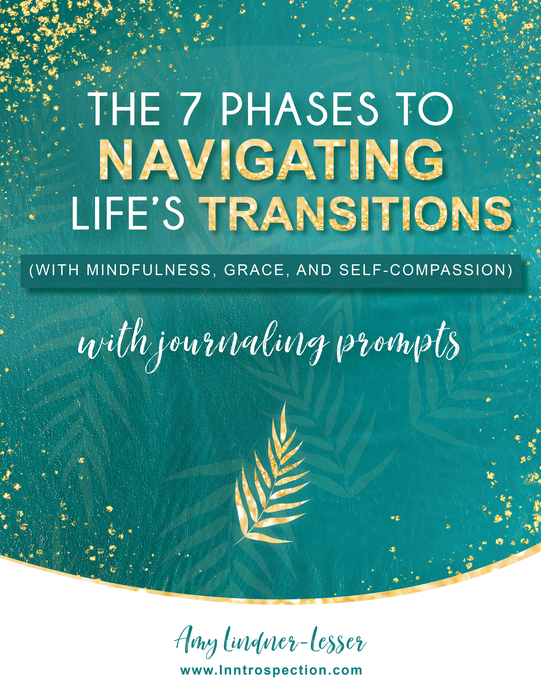
Navigating life transitions often results in feelings of grief, overwhelm, sadness, burnout, loneliness, and loss. Grief happens to all of us.
Each time we experience a life-altering transition, grief is triggered, it could be the death of a loved one, the ending of a friendship (even by our own choice), the loss of a job, infertility, adoption, a major move, change in relationship status, or loss of income. We can also feel grief when the transition is perceived as positive as in graduation, getting married, or having a baby. Grief doesn’t discriminate nor are we adept at dealing with difficult emotions.
Our minds and bodies react to the change in our lives. If we don’t deal with the emotions, the grief shows up in other ways like anger at ourselves or others, drinking, overeating or undereating, and workaholism, to name a few.
At some point, this is different for each of us and with each change, we are ready to move forward. This doesn’t mean forgetting or pretending the event didn’t happen. It means the pain of staying where we are is worse than the idea of moving forward.
Here are seven steps to find the silver linings that can help you move forward.
1. Hold Space for the Silver Linings. At the beginning of your life transition, you may not see, or even believe, there could be a silver lining. It takes some time and is different for each person and each time. It is important not to compare with past experiences or with. Unfortunately, there is no map or GPS to follow. We must become our own guides, determine our next steps, and be flexible enough to reroute when necessary.
AFFIRMATION: I am open to seeing the silver linings of my situation.
2.Give Yourself Grace. Treat yourself as you would a dear friend or family member. Be gentle and give yourself permission to feel all the feelings – even the ones that are uncomfortable. Start a gratitude practice. Each day write down at least three things, people, or events you are grateful for. It may be difficult at first, but as you progress it will get easier, and you will find your gratitude expanding.
AFFIRMATION: I am getting comfortable with the uncomfortable. When I am having a hard day, I am compassionate with myself.
3.Embrace a Thriver Mindset. An important part of navigating your transition is being conscious of your mindset in every moment. By doing so you can learn to hold a Thriver mindset that empowers you instead of holding a disempowering Survivor Mindset. As a Thriver, you are in control and not controlled by outside thoughts or opinions. You take responsibility for yourself. Things happen for you (positive thriver) rather than to you (passive survivor).
AFFIRMATION: I have the power to thrive in every area of my life. I accept responsibility for my decisions and strive to thrive not merely survive! My ability to conquer any challenge and thrive is limitless.
4.Ask for and Accept Support. You are not meant to go through this journey alone. Allowing yourself to ask for and accept support is a critical part of the healing process. Being in community is a deep human need and is very validating so that you don’t feel alone. When you’re feeling alone or vulnerable it is healing and supportive to reach out to another person – a friend, family member, or professional who can simply hold space and listen to you. You don’t need advice, only a caring person to listen. If you don’t feel you have that person, reach out. Join a support group, and/or find a coach or a therapist.
AFFIRMATION: I ask for and accept help when I need it. I am loved and supported by my community. I do not have to go through this alone.
5.Practice Self-Care and Set Boundaries
Be gentle with yourself and take extra steps to provide yourself with lots of self-care. It doesn’t have to cost money. Self-care can be simple – reading, meditating, walking, taking a bath, listening to favorite music, dancing, or a pretty drive.
Set boundaries to protect your energy. Learn to say no to invitations that you are not comfortable with. NO is a complete sentence. Try new experiences and join with others who are going through similar transitions – at least once. You can say no the next time if it isn’t right. If you don’t try who knows if it might have been a great opportunity.
AFFIRMATION: I take extra time for self-care showing myself compassion and grace. I set and maintain boundaries to protect my energy and my mindset.
6.Acknowledge and Celebrate Your Growth. We tend to judge and compare where we are with where we think we ‘should’ be. An important part of the healing journey is acknowledging our growth at various stages of that journey. As you navigate through your transition, permit yourself to celebrate even the smallest of milestones. Some days this means celebrating that you took a shower and put on clean clothes. Other days it might mean taking your dog for a walk or going to your mailbox. And on some days being able to make it through the day without crying or eating that pint of ice cream. Whatever it is, give it and yourself credit! You’ve moved forward!
AFFIRMATION: I celebrate each step of my journey. I know that I am moving forward with each milestone regardless of the size. I know that whether it seems like I’m going forward, backward, or sideways, I am moving and that means I am growing!
7.Identify Your Silver Lining. Take some time to reflect on the changes in your life since your life disruption. What are you now doing that you couldn’t before? Have you gained new skills or insights? What changes have you made in your life? How have you grown?
One of the gifts I have found in navigating grief (more than 30 lifequakes in 60 years) is that while life will never be the same as it was before, finding the silver linings can be freeing. This may be the perfect time to redefine yourself and decide who and what you want to be. You don’t have to meet anyone else’s ideas or expectations.
AFFIRMATION: I can identify ways in which I have grown since my life transition and see the lessons I have learned. I can see the positive within the experience.




